First, a bit of background…
In our conversations around makerspaces over the past year and half, we’ve heard several concerns around the cost of materials for student projects, and the effort involved to secure material donations.
Schools need material for student projects but:
- They have limited budgets
- It’s time consuming to track down potential donors
- They can’t always find donors for what they need
There are a parallel set of concerns on the industry side. Companies are willing to donate material for use in schools but:
- They don’t know always know what is useful
- They don’t know who needs it
- They don’t have a simple means to do so
We started exploring a model for getting excess material from industry available for use in area schools last January when we partnered with Betty Brinn to sponsor a challenge through The Commons. That work continued over the summer and fall as we experimented with pulling equipment from Gooodwill’s E-Cycling stream for tear down events to recover useful parts.
The challenge of getting excess materials to educators has been addressed in the Bay Area through a non-profit called the Resources Area For Teaching (RAFT). While they do a great job at pulling material in and packaging it up, the relationships that develop with donor companies are with RAFT. Given all the efforts we see to help schools develop relationships with area firms and career based learning experiences (CBLEs), we see that as the wrong model for Milwaukee.
We’d like to see schools use up-cycling as another point of engagement with the companies around them. The idea is to develop a network exchange model, where participants have access to materials their counterparts are able to pull in. That network could include not just K12 schools, but libraries, museums, and other organizations who can provide or use up-cycled materials for student projects.
In a network model, we need a way to create a view of inventory that is spread across nodes. It turns out that a couple of the leading thinkers on network resource planning live in western Wisconsin. They have developed an open source platform that facilitates the kind of network we envision. We’ve paired them up with a team of MSOE students who are working to tailor the application to see how it would work for us. We’re starting with the simple stuff– let me see who is in the network, and what is available.
The model we proposed looks like this:
- Non-Profit consortium
- Supported by membership fees
- Members issued credits used to purchase material
- Members set pricing (in credits) for material/services they offer
- Consortium sets membership fees/credit pricing
- Supported by open source NRP platform
And now, the recap…
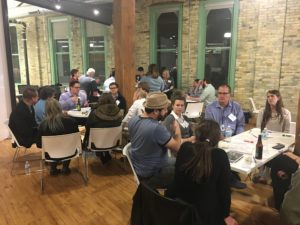 During Collab Lab 16, we walked participants through our model and had them beat up the idea in both small group discussions and a sharing out of key points to all participants.
During Collab Lab 16, we walked participants through our model and had them beat up the idea in both small group discussions and a sharing out of key points to all participants.
Participants listed the following as key questions/concerns for each player in the model:
Donors
- Liability for downstream use
- Transportation/Logisticcs
- Visibility of need — how do we know who needs what?
- Impact on student learning
Aggregators/Distributors of Donated Material
- Liabilty
- Compensation
- Sustainable model
- Space limitations within schools
Recipients
- Getting the right stuff
- Equitable cost structure
- Ensuring equal access
- Growing the network/community collaboration (share recipes)
We then prompted the discussion groups to think through experiments that could help validate potential solutions to these concerns. That generated:
- A commitment from Digital Bridges to provide laptops for a tear down event at one of the schools participating, and to document the lessons learned from the process.
- Involve students in understanding how to acquire donated material by having them explore potential relationships with area firms.
- Start the network, learn and grow:
- Start with a simple catalog
- Let participants work out transportation of materials
- Skip the distributor role for now
- 4 column spreadsheet for catalog
- Promotion to potential network nodes
- Communicate to actual users.
- Next Steps
Quick & Dirty Has/Wants Directory
We like the idea of prototyping with a shared spreadsheet that can serve as a directory of folks at schools and other organizations that have material or skills that may be useful to others, or have something they are looking for and could use help finding it. Here it is: https://tinyurl.com/y7uas8h3
Feel free to add/edit/share. We added attendees from schools as editors, but the link is set to view only for everyone else. If you’d like access, let us know.
School/Donor Interviews
We also want a better understanding of how schools work with companies who make material donations on an ongoing basis. If you have a such a relationship, we’d like to sit down with you and your contact at the company to walk through your current process, talk through what works, and what gets in the way, and what would help make the process better. If you’d like to bring along a student who is, or would like to be involved in the process, we’d more than welcome that. We have time to schedule six of these discussions between now and the first week of March. If you’d like to be included, let us know.
Thanks again to The Commons for providing the space, and to everyone who joined us for the insight they brought to the discussion. We had several folks from outside of K12 join us (thank you). For those who asked how you could find them, here you go:
Rachel Arbit — Senior Director of Programs, SHARP Literacy
Ben Dembroski — Open Lab Manager, MIAD
Kelly Ellis — CEO, Einstein Project
Jeff Hanson — Executive Director, Digital Bridge
Lisa Perkins — Re-Creation Station
Owen Raisch — Associate Director, Student Run Business Program, Marquette University

 During Collab Lab 16, we walked participants through our model and had them beat up the idea in both small group discussions and a sharing out of key points to all participants.
During Collab Lab 16, we walked participants through our model and had them beat up the idea in both small group discussions and a sharing out of key points to all participants.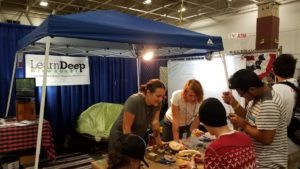 In September we took the equipment we had left to Maker Faire where we were mobbed for three days by kids wanting to take stuff apart. A number of educators who stopped by the booth asked if we could do something like this at their school.
In September we took the equipment we had left to Maker Faire where we were mobbed for three days by kids wanting to take stuff apart. A number of educators who stopped by the booth asked if we could do something like this at their school.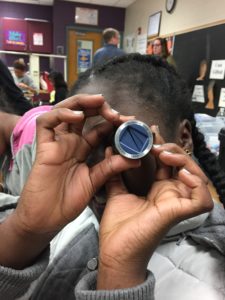 Last Tuesday we went out to Thurston Woods where students took apart DVD drives, a circular saw, printer, keyboard, camera, and a few other odds and ends in our collection. Today we were out at Browning Elementary to do more of the same. We were thrilled to see the students dive in and work together with little more instruction than “righty-tighty, lefty-loosey”.
Last Tuesday we went out to Thurston Woods where students took apart DVD drives, a circular saw, printer, keyboard, camera, and a few other odds and ends in our collection. Today we were out at Browning Elementary to do more of the same. We were thrilled to see the students dive in and work together with little more instruction than “righty-tighty, lefty-loosey”.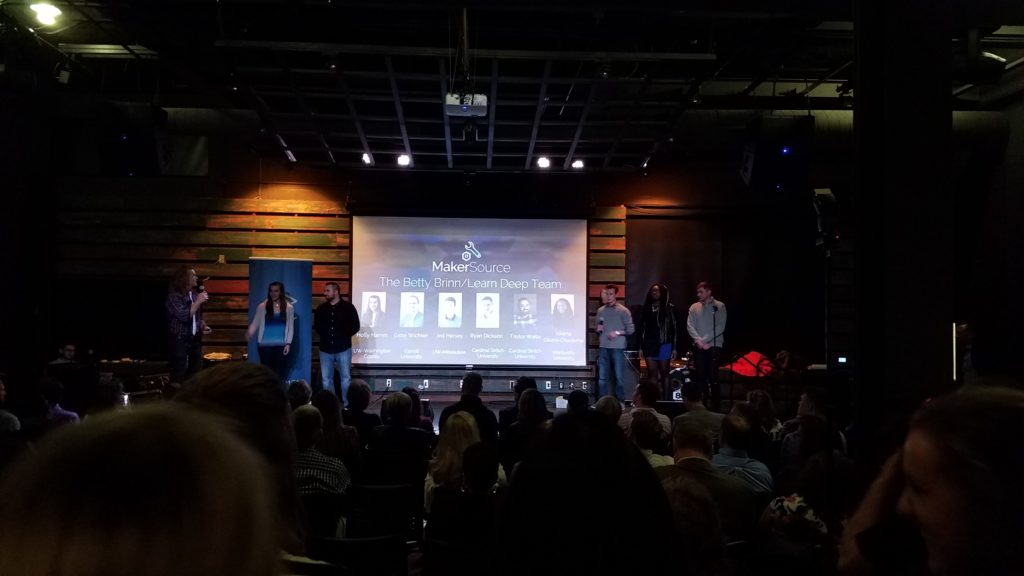 Tuesday was pitch night at 88.9 for The Commons. The Betty Brinn/Learn Deep team shared their vision of CSA-farm-box meets up-cycling. The solution looks to offer schools a subscription service that delivers a mystery box of materials for use in a makerspace on a monthly basis. Great idea, go team!
Tuesday was pitch night at 88.9 for The Commons. The Betty Brinn/Learn Deep team shared their vision of CSA-farm-box meets up-cycling. The solution looks to offer schools a subscription service that delivers a mystery box of materials for use in a makerspace on a monthly basis. Great idea, go team!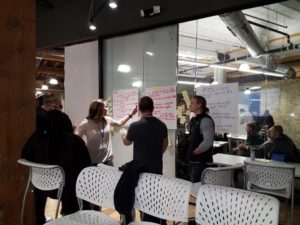
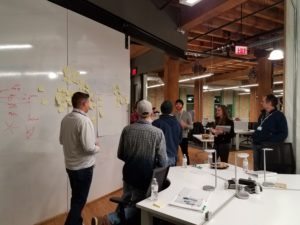
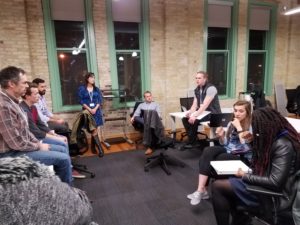
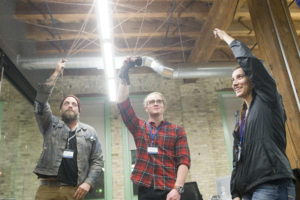 Last night at Ward 4 The Commons revealed the teams for each of this semester’s challenges. After a getting-to-know-each-other exercise that involved great lengths of yarn and a couple of well placed metaphors, the teams got to work. Joost, Mike Cook and I walked our team through the challenge to find a sustainable way excess materials from area firms could be made available for Betty Brinn’s maker initiatives and the makerspaces/FabLabs within area schools. The team’s work for this week is to look at how other organizations have solved the problem.
Last night at Ward 4 The Commons revealed the teams for each of this semester’s challenges. After a getting-to-know-each-other exercise that involved great lengths of yarn and a couple of well placed metaphors, the teams got to work. Joost, Mike Cook and I walked our team through the challenge to find a sustainable way excess materials from area firms could be made available for Betty Brinn’s maker initiatives and the makerspaces/FabLabs within area schools. The team’s work for this week is to look at how other organizations have solved the problem.
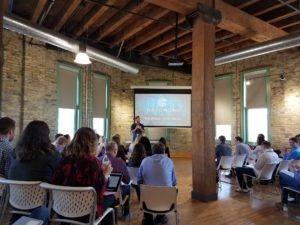 We partnered with Betty Brinn Children’s Museum to formulate this challenge over the past weeks. We are challenging a team to create a pitch for a sustainable startup to provide surplus materials to the Betty Brinn Children’s Museum’s Maker Initiative as well as area school’s maker programs. We spent Sunday afternoon at Ward 4 with Carrie Wettstein and Mike Cook from Betty Brinn to introduce our challenge and meet prospective team members.
We partnered with Betty Brinn Children’s Museum to formulate this challenge over the past weeks. We are challenging a team to create a pitch for a sustainable startup to provide surplus materials to the Betty Brinn Children’s Museum’s Maker Initiative as well as area school’s maker programs. We spent Sunday afternoon at Ward 4 with Carrie Wettstein and Mike Cook from Betty Brinn to introduce our challenge and meet prospective team members.